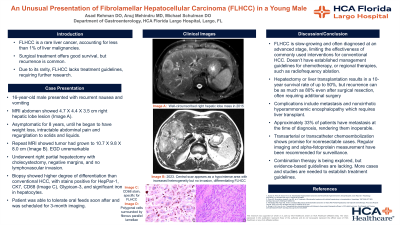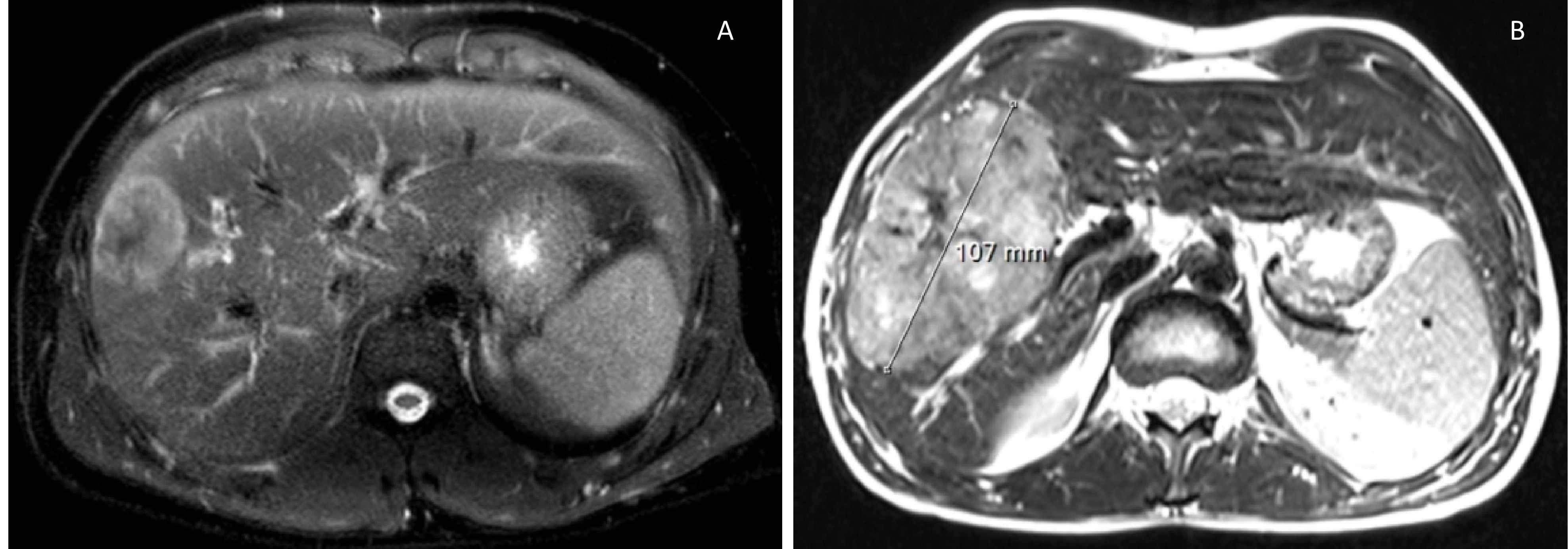Sunday Poster Session
Category: Liver
P1099 - An Unusual Presentation of Fibrolamellar Hepatic Cell Carcinoma (FLHCC) in a Young Male
Sunday, October 22, 2023
3:30 PM - 7:00 PM PT
Location: Exhibit Hall

Has Audio
.jpg)
Asad Rehman, DO
HCA Healthcare
Houston, TX
Presenting Author(s)
Asad Rehman, DO1, Anuj Mehindru, MD2, Michael Schulman, MD2
1HCA Healthcare, Largo, FL; 2HCA West Florida Largo Medical Center, Largo, FL
Introduction: Fibrolamellar hepatic cell carcinoma (FLHCC) is a rare liver cancer, accounting for less than 1% of liver malignancies. Unrelated to cirrhosis or chronic liver disease, it equally affects young men and women. Diagnosis involves imaging and biopsy. Surgical treatment offers good survival, but recurrence is common. Due to its rarity, FLHCC lacks treatment guidelines, requiring further research. Our case aims to add to the growing body of literature of the varying presentations of FLHCC.
Case Description/Methods: A 16-year-old male presented initially with only one day of nausea and vomiting. MRI of the abdomen showed a liver lesion occupying the right lobe measuring approximately 4.7 X 4.4 X 3.5 cm. Patient was asymptomatic for 8 years, until he began to have weight loss, intractable abdominal pain and regurgitation to solids and liquids. Repeat MRI abdomen showed the tumor had grown to 10.7 X 9.8 X 8.0 cm. EGD was negative for any gastric or small bowel involvement. The patient underwent successful right partial hepatic resection with cholecystectomy, negative margins, and no lymphovascular invasion. Intraoperative biopsy confirmed the diagnosis, revealing a higher degree of differentiation than conventional HCC, with stains positive for HepPar-1, CK7, CD68, Glypican-3, and significant iron in hepatocytes. The patient was able to tolerate oral feeds soon after. He was scheduled for 3-month imaging.
Discussion: This case highlights how FLHCC is slow-growing and often diagnosed at an advanced stage, limiting the effectiveness of commonly used interventions for conventional HCC. Due to its rarity, there are no established management guidelines for chemotherapy, or locoregional therapies, such as radiofrequency ablation. Partial hepatectomy or liver transplantation results in a 10-year survival rate of up to 50%, however recurrence can be as much as 80% even after surgical resection, often requiring additional surgery. Other complications include metastasis and noncirrhotic hyperammonemic encephalopathy which requires liver transplant. Approximately 33% of patients have metastasis at the time of diagnosis, rendering them inoperable. Intraarterial treatment like transarterial or transcatheter oily chemoembolization shows promise for nonresectable cases. As for surveillance, regular imaging and alpha-fetoprotein measurement have been recommended. Combination therapy is being explored, but evidence-based guidelines are lacking. More cases and studies are needed to establish treatment guidelines.

Disclosures:
Asad Rehman, DO1, Anuj Mehindru, MD2, Michael Schulman, MD2. P1099 - An Unusual Presentation of Fibrolamellar Hepatic Cell Carcinoma (FLHCC) in a Young Male, ACG 2023 Annual Scientific Meeting Abstracts. Vancouver, BC, Canada: American College of Gastroenterology.
1HCA Healthcare, Largo, FL; 2HCA West Florida Largo Medical Center, Largo, FL
Introduction: Fibrolamellar hepatic cell carcinoma (FLHCC) is a rare liver cancer, accounting for less than 1% of liver malignancies. Unrelated to cirrhosis or chronic liver disease, it equally affects young men and women. Diagnosis involves imaging and biopsy. Surgical treatment offers good survival, but recurrence is common. Due to its rarity, FLHCC lacks treatment guidelines, requiring further research. Our case aims to add to the growing body of literature of the varying presentations of FLHCC.
Case Description/Methods: A 16-year-old male presented initially with only one day of nausea and vomiting. MRI of the abdomen showed a liver lesion occupying the right lobe measuring approximately 4.7 X 4.4 X 3.5 cm. Patient was asymptomatic for 8 years, until he began to have weight loss, intractable abdominal pain and regurgitation to solids and liquids. Repeat MRI abdomen showed the tumor had grown to 10.7 X 9.8 X 8.0 cm. EGD was negative for any gastric or small bowel involvement. The patient underwent successful right partial hepatic resection with cholecystectomy, negative margins, and no lymphovascular invasion. Intraoperative biopsy confirmed the diagnosis, revealing a higher degree of differentiation than conventional HCC, with stains positive for HepPar-1, CK7, CD68, Glypican-3, and significant iron in hepatocytes. The patient was able to tolerate oral feeds soon after. He was scheduled for 3-month imaging.
Discussion: This case highlights how FLHCC is slow-growing and often diagnosed at an advanced stage, limiting the effectiveness of commonly used interventions for conventional HCC. Due to its rarity, there are no established management guidelines for chemotherapy, or locoregional therapies, such as radiofrequency ablation. Partial hepatectomy or liver transplantation results in a 10-year survival rate of up to 50%, however recurrence can be as much as 80% even after surgical resection, often requiring additional surgery. Other complications include metastasis and noncirrhotic hyperammonemic encephalopathy which requires liver transplant. Approximately 33% of patients have metastasis at the time of diagnosis, rendering them inoperable. Intraarterial treatment like transarterial or transcatheter oily chemoembolization shows promise for nonresectable cases. As for surveillance, regular imaging and alpha-fetoprotein measurement have been recommended. Combination therapy is being explored, but evidence-based guidelines are lacking. More cases and studies are needed to establish treatment guidelines.

Figure: Image A) Well-circumscribed right hepatic lobe mass measuring 4.7 X 4.4 X 3.5 cm in 2015. Image B) Tumor grew to 10.7 X 9.8 X 8.0 cm prior to resection in 2023. Noted to have an increasing central scar, which appears as a hypointense area differentiating FLHCC from other types of liver cancers. Tumor demonstrated increased heterogeneity but no invasion.
Disclosures:
Asad Rehman indicated no relevant financial relationships.
Anuj Mehindru indicated no relevant financial relationships.
Michael Schulman indicated no relevant financial relationships.
Asad Rehman, DO1, Anuj Mehindru, MD2, Michael Schulman, MD2. P1099 - An Unusual Presentation of Fibrolamellar Hepatic Cell Carcinoma (FLHCC) in a Young Male, ACG 2023 Annual Scientific Meeting Abstracts. Vancouver, BC, Canada: American College of Gastroenterology.
